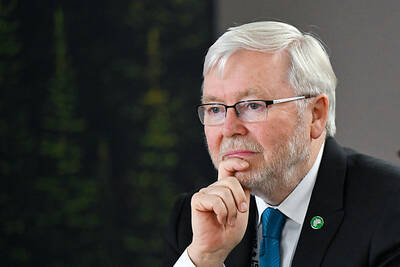Tuesday was another typical day for John Chow, blogger and Internet entrepreneur in Vancouver, British Columbia. Chow treated his 50,000 Twitter followers to a photograph of his lunch (barbecued chicken and French fries), discussed the weather in Vancouver and linked to a new post on his Internet business blog.
Then he earned US$200 by telling his fans where they could buy M&M’s with customized faces, messages and colors.
Chow is among a growing group of celebrities, bloggers and regular Internet users who are allowing advertisers to send commercial messages to their personal contacts on social networks.
For the last month, he has used the services of Ad.ly, a start-up based in Los Angeles, and Izea, based in Orlando, Florida, to periodically surrender his Twitter stream to the likes of Charter Communications, the Make a Wish Foundation and an online seminar about working from home.
Last month, Chow’s income from Twitter ads was around US$3,000.
“I get paid for pushing a button,” he said.
It is perhaps the last frontier in advertising — getting regular people to send a sentence or two of text, on behalf of paying advertisers, to their friends and admirers. The idea, according to the entrepreneurs who are developing such services for Twitter and other Web networks, is that people trust recommendations from those they know and respect, while they increasingly ignore nearly ever other kind of ad message in print, on television and online.
Even the Internet giants are warming to the idea of harnessing informal chats between friends to promote their products and services. This month, Amazon.com said it would start paying commissions to individuals who refer buyers to the site via Twitter messages. (People must first sign up for Amazon Associates, a program in which Amazon pays Web publishers for referrals to its site.)
But the bigger opportunity may be in matching advertisers with so-called influencers — the more popular users of services like Twitter. A number of start-ups, like Ad.ly, Izea and Peer2, a division of Creative Asylum, a Hollywood ad agency, are pursuing the opportunity to put persuasive messages into regular dialogue on social networks.
“We don’t want to create an army of spammers, and we are not trying to turn Facebook and Twitter into one giant spam network,” said Joey Caroni, co-founder of Peer2. “All we are trying to do is get consumers to become marketers for us.”
For the most popular celebrities and bloggers on Twitter, such advertising can generate a surprisingly sizable payday.
Ad.ly and Izea, which runs a service called Sponsored Tweets, say celebrities like Kim Kardashian, Dr Drew and the musician Ernie Halter can earn up to US$10,000 by sending a single message to their hundreds of thousands of followers. (Sample ad Tweet from Halter, which included a link: “sponsored: yo! cheese doodles is giving away sweet prizes in the “rock the cheese” video contest. Check it!”)
Izea receives at least 15 percent of the advertiser’s payment to more popular Twitter users, and up to half for the less distinguished.
Ad.ly takes a 30 percent cut across the board. While both companies note their celebrity connections and the involvement of big advertisers like Microsoft and NBC, they really salivate at the prospect of marrying less notable Internet personalities with the huge pool of smaller advertisers.
For example, an expert on cycling, with 1,000 Twitter followers, might agree to send an ad about a new bike helmet — a message that might well be implicitly trusted by his followers.
One problem is that many Internet users eschew the idea of these ads, saying they commercialize authentic dialogue and undermine people’s credibility.
“It interferes with your relationship with your friends and your audience,” said Robert Scoble, a technology blogger with more than 100,000 followers on Twitter, who says he “unfollows” people on Twitter who send him ads.
Facebook does not allow members to insert paid ads into status updates or profiles.
“For us, it goes against the authenticity of the page,” said Brandon McCormick, a Facebook spokesman.
Peer2 gets around the ban by offering users points instead of dollars; points are redeemable for Amazon products.
Part of the unease with this emerging form of advertising is rooted in the past. Three years ago, with a service called PayPerPost, Izea paid bloggers to pitch products to their readers.
The endorsements were not clearly labeled as ads, and the service kicked up a dust storm of criticism in the blogosphere.
Ted Murphy, the CEO of Izea, a 30-person business backed by US$10 million in venture capital, said the company initially “made a big mistake” by not setting disclosure standards for publishers and advertisers.
Today, ad networks promote their standards; Izea’s ads on Twitter are typically demarcated with signifiers like “#ad” or “#sponsor.”
One new company trying to add transparency to the business is Likes.com of San Francisco, which plans to introduce its ad network next month.
The company encourages bloggers and Twitter users to specify their tastes in restaurants, movies, books, music and other products, and then to publish those recommendations to their blogs and social network pages.
Advertisers can then see who has favored their products in the past, and how effective their recommendations have been at getting other people to click on links.
Depending on the advertiser, bloggers and Tweeters will be paid for every ad they send out, or every time someone clicks on the link.
Every Likes.com ad is clearly labeled as such, and once people click on a link, they are taken to another page that is also clearly labeled as a sponsorship.
People are limited to posting an ad from Likes.com once every other day.
“We are trying to limit it, to prevent people from losing their following,” said Bindu Reddy, a former Google product manager who started the company with her husband, Arvind Sundararajan, a former Google engineer. “We know people are queasy about this.”

NEXT GENERATION: The four plants in the Central Taiwan Science Park, designated Fab 25, would consist of four 1.4-nanometer wafer manufacturing plants, TSMC said Taiwan Semiconductor Manufacturing Co (TSMC, 台積電) plans to begin construction of four new plants later this year, with the aim to officially launch production of 2-nanometer semiconductor wafers by late 2028, Central Taiwan Science Park Bureau director-general Hsu Maw-shin (許茂新) said. Hsu made the announcement at an event on Friday evening celebrating the Central Taiwan Science Park’s 22nd anniversary. The second phase of the park’s expansion would commence with the initial construction of water detention ponds and other structures aimed at soil and water conservation, Hsu said. TSMC has officially leased the land, with the Central Taiwan Science Park having handed over the

AUKUS: The Australian Ambassador to the US said his country is working with the Pentagon and he is confident that submarine issues will be resolved Australian Ambassador to the US Kevin Rudd on Friday said that if Taiwan were to fall to China’s occupation, it would unleash China’s military capacities and capabilities more broadly. He also said his country is working with the Pentagon on the US Department of Defense’s review of the AUKUS submarine project and is confident that all issues raised will be resolved. Rudd, who served as Australian prime minister from 2007 to 2010 and for three months in 2013, made the remarks at the Aspen Security Forum in Colorado and stressed the longstanding US-Australia alliance and his close relationship with the US Undersecretary

‘WORLD WAR III’: Republican Representative Marjorie Taylor Greene said the aid would inflame tensions, but her amendment was rejected 421 votes against six The US House of Representatives on Friday passed the Department of Defense Appropriations Act for fiscal 2026, which includes US$500 million for Taiwan. The bill, which totals US$831.5 billion in discretionary spending, passed in a 221-209 vote. According to the bill, the funds for Taiwan would be administered by the US Defense Security Cooperation Agency and would remain available through Sept. 30, 2027, for the Taiwan Security Cooperation Initiative. The legislation authorizes the US Secretary of Defense, with the agreement of the US Secretary of State, to use the funds to assist Taiwan in procuring defense articles and services, and military training. Republican Representative

TAIWAN IS TAIWAN: US Representative Tom Tiffany said the amendment was not controversial, as ‘Taiwan is not — nor has it ever been — part of Communist China’ The US House of Representatives on Friday passed an amendment banning the US Department of Defense from creating, buying or displaying any map that shows Taiwan as part of the People’s Republic of China (PRC). The “Honest Maps” amendment was approved in a voice vote on Friday as part of the Department of Defense Appropriations Act for the 2026 fiscal year. The amendment prohibits using any funds from the act to create, buy or display maps that show Taiwan, Kinmen, Matsu, Penghu, Wuciou (烏坵), Green Island (綠島) or Orchid Island (Lanyu, 蘭嶼) as part of the PRC. The act includes US$831.5 billion in